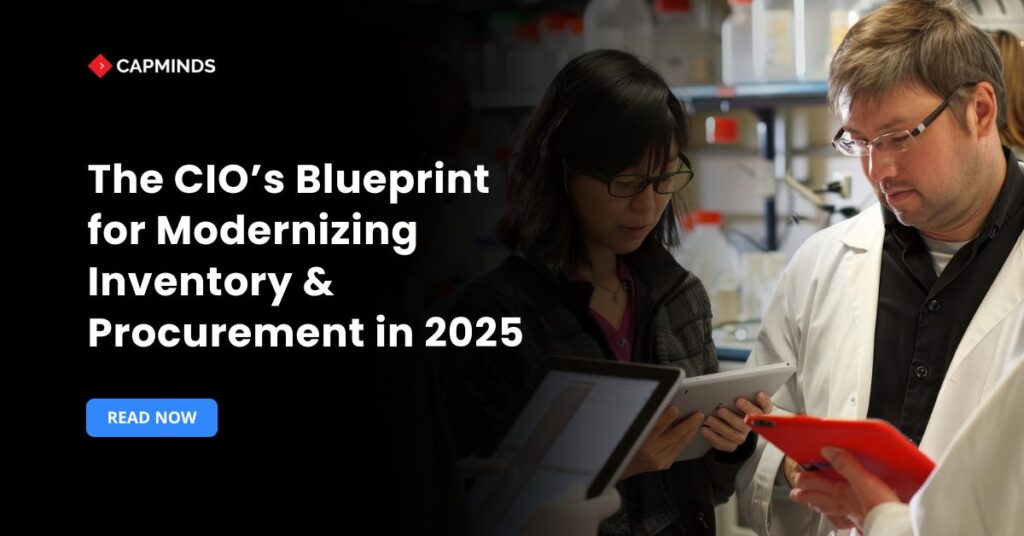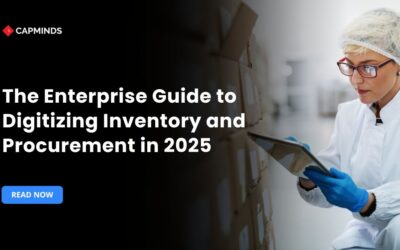The CIO’s Blueprint for Modernizing Inventory & Procurement in 2025
Hospital supply chains and inventory management have entered a new era of urgency and innovation. The COVID-19 pandemic and ongoing cost pressures exposed the fragility and inefficiency of legacy procurement systems in healthcare. Studies estimate that nearly 30% of hospital supply chain spending currently goes to waste – an unsustainable figure as health systems strive for value-based care and financial resilience.
Indeed, 69% of healthcare organizations now say procurement plays a pivotal role in value analysis to drive cost savings. In this context, Chief Information Officers are uniquely positioned to lead a digital transformation of inventory and procurement processes. Modernizing these functions isn’t just an IT upgrade; it’s a strategic imperative to reduce costs, eliminate waste, ensure compliance, and ultimately improve patient care outcomes.
CIOs can craft a blueprint for modernization by leveraging advanced technologies, including cloud-based ERP platforms, Internet of Things devices, and artificial intelligence. The healthcare industry is moving toward a “real-time health system” paradigm that depends on digitalization and timely data.
Yet many providers remain hamstrung by manual processes and siloed legacy systems. Transforming this status quo requires informed and inspired leadership willing to champion enterprise-wide changes. This blog outlines a CIO’s blueprint for modernizing inventory and procurement in healthcare for 2025, highlighting key technologies, benefits, and real-world case studies of hospitals already reaping the rewards.
The Case for Modernizing Inventory & Procurement in Healthcare
Modernizing supply chain operations is not just about new tech; it addresses fundamental challenges in healthcare procurement and inventory management:
1. Inefficiencies and High Costs
Fragmented systems and manual inventory tracking lead to overstocking, stockouts, and expirations. Overstocking ties up capital and space, while understocking risks patient care delays.
These inefficiencies contribute directly to higher operating costs.
- For example, one health system found that better transparency and management of inventory could save an estimated $68 million over 10 years, through measures like a 23% reduction in stock levels and tens of thousands saved by avoiding expired products.
- Such savings free up resources that can be redirected to patient care.
2. Waste and Expiration of Supplies
Many hospitals still rely on periodic manual counts and reactive ordering, resulting in expired medications and devices. In the BJC HealthCare pilot cited above, simply improving tracking led to capturing $30,000 in savings from expired product avoidance in one year.
IoT-based smart inventory systems now generate alerts for items nearing expiration so they can be used in time, directly preventing unnecessary waste.
3. Compliance and Risk Management
Healthcare is highly regulated – from FDA requirements for device tracking to standards like England’s NHS HTM71 for materials management. Outdated inventory processes make it harder to trace products for recalls or ensure the right implant is used for the right patient. Modern supply chain solutions help meet regulatory mandates by providing end-to-end visibility and traceability.
- For instance, an RFID-based inventory system aligned with NHS standards can automatically track surgical implants from delivery to the operating room, ensuring the correct item is used and alerting staff if the wrong item is selected, drastically reducing the chance of life-threatening mistakes.
- This not only improves patient safety but also strengthens compliance and Joint Commission audit readiness.
4. Impact on Patient Care
Inventory and procurement may be “back-office” functions, but they have a direct impact on patient outcomes. A missing surgical instrument or an out-of-stock medication can delay critical treatments. Inefficient supply chains also consume clinicians’ time – every hour nurses spend hunting for supplies or filling out purchase forms is an hour less at the bedside.
By modernizing and automating these processes, hospitals can decrease nursing and clinician time spent on inventory tasks, allowing more time for patient care. Reliable supply availability means surgeries and treatments proceed without delay, contributing to better patient outcomes and satisfaction.
Given these drivers, the urgency to modernize is clear. The good news: powerful new technologies are available to re-engineer healthcare supply chains for efficiency, resilience, and agility. Below is a CIO’s blueprint of key strategies and tools to transform inventory and procurement in 2025.
Key Pillars of the Modernization Blueprint
1. Cloud-Based ERP Systems as a Foundation
Upgrading to a cloud-based Enterprise Resource Planning system is often the cornerstone of supply chain modernization. Traditionally, hospitals ran on-premises materials management or ERP systems that were siloed and costly to maintain.
- Today, there is a rapid shift toward cloud-based healthcare supply chain management, with estimates that 70% of health systems will adopt a cloud approach by 2026.
- Cloud-based ERP platforms offer unified procurement, inventory, and finance modules that seamlessly integrate with other systems.
- Unlike on-prem software, cloud solutions are maintained by the provider, so hospitals always have up-to-date features without the heavy IT overhead.
Related: The Comprehensive Role of ERP Systems in Healthcare
Benefits:
A cloud ERP brings real-time visibility into supply chain data across the enterprise. Processes that were once paper-based can be digitized and standardized.
- In a recent industry survey, hospital leaders cited streamlined operations, cost reduction, better analytics, and fewer manual tasks as key benefits of moving to cloud supply chain systems.
- Because all data resides in one platform, staff can generate analytics and reports that inform smarter purchasing and stock level decisions.
- Cloud systems also improve agility – they can be accessed securely from anywhere, enabling supply chain staff to work remotely or on mobile devices with full functionality.
- As one supply chain director noted after his health system’s cloud ERP go-live, “The fact that I can now check the status of a PO anytime, anywhere is pretty exciting… having that kind of power from the Cloud… Would we do it again? Yes, absolutely in a heartbeat.”.
- Furthermore, cloud platforms easily connect with suppliers and partners via APIs or electronic data interchange.
For example, Lurie Children’s Hospital integrated its cloud ERP with its procurement network to receive advance shipping notifications and better manage substitutions, greatly improving supply chain resiliency.
Overall, adopting a cloud-first ERP strategy sets the stage for all other innovations, as it provides the unified data backbone and scalability needed for IoT devices and AI analytics to plug in seamlessly.
2. IoT and Real-Time Inventory Tracking
Modernizing inventory management in healthcare increasingly relies on Internet of Things technologies – especially RFID tags, sensors, and “smart” storage. IoT devices can automatically monitor the location, quantity, and condition of supplies in real time without human intervention. Smart cabinets and RFID-tagged inventory are becoming game-changers in hospitals.
- For example, high-value implants or critical medications can be tagged with RFID and stored in automated cabinets.
- Each time an item is added or removed, the cabinet’s reader updates the central inventory system instantly, providing accurate, up-to-the-minute stock levels.
- These systems can even monitor conditions and send alerts if a threshold is breached. The result is far fewer manual counts and a dramatic reduction in lost or expired items.
Real-world example
BJC HealthCare’s supply chain modernization, which included RFID tracking, achieved a 23% reduction in par inventory levels and virtually eliminated stockouts of critical supplies.
Similarly, an IoT-enabled solution in the UK tracks surgical implants from the loading dock to the operating room, ensuring that the right implant is at hand for the right patient at the right time. If an implant is misplaced or nearing expiration, the system alerts staff so they can act before it causes a surgery delay or waste.
For CIOs, IoT integration means deploying the infrastructure (RFID tags, sensors, and network connectivity) and integrating these streams of data with the inventory management or ERP system. Many hospitals start with pilot projects in high-impact areas like cath labs, operating rooms, or pharmacy inventories.
When designed well, IoT-powered inventory management yields significant cost savings (one hospital saw ~$30k annual savings just by catching expiring products), frees up staff from counting supplies, and improves patient safety through better availability of the right items.
It also enhances compliance: automated tracking makes it easier to trace items for recalls and to document chain-of-custody for critical implants or controlled substances (important for audit and regulatory requirements).
3. Artificial Intelligence and Predictive Analytics
The next pillar of the CIO’s blueprint is leveraging AI and machine learning to turn data into actionable insights. In procurement and inventory, AI excels at demand forecasting, optimization, and decision support. By analyzing historical usage patterns, seasonal trends, and even real-time clinical data, AI algorithms can predict what supplies will be needed, where, and when.
This enables a shift from reactive ordering to proactive planning, ensuring optimal inventory levels that minimize both shortages and excess.
- Some hospitals have implemented AI-driven inventory management and reduced inventory costs by up to 30% while still ensuring critical supplies are always available.
- AI can identify subtle usage patterns or anomalies and alert managers to adjust orders accordingly, reducing last-minute expensive rush orders.
- AI and advanced analytics also help in procurement optimization.
- Machine learning models can analyze purchase histories and market prices to identify the best sourcing opportunities or contract compliance issues.
- AI-powered tools are now assisting healthcare procurement teams with value analysis – identifying which products deliver the best outcomes for cost, and standardizing those across the system.
- This supports the broader trend of tying procurement to value-based care.
Furthermore, AI can automate routine procurement tasks: from auto-reordering common supplies when thresholds are met, to matching invoices, to selecting the best supplier based on performance data. By offloading repetitive tasks and augmenting human decision-making, AI allows supply chain staff to focus on strategic activities.
The results are lower operational costs and a more resilient supply chain. As a bonus, modern AI tools often come embedded in cloud ERP or supply chain platforms, or can be added as modules, making it easier for CIOs to deploy them as part of the overall system upgrade.
4. Data Integration and Analytics
A modernized inventory/procurement function thrives on data interoperability. CIOs should ensure that supply chain systems are integrated with other hospital information systems, especially the Electronic Health Record, financial systems, and supplier networks.
- When inventory data is connected with patient care data, hospitals can perform insightful analytics: for example, correlating supply usage with patient outcomes, or tracking cost per surgical procedure in real time.
- Integration with supplier networks brings additional benefits like advanced shipment notifications, electronic purchase orders, and tracking information that improve planning and reduce uncertainty.
A unified, cloud-based system makes such integration far easier than in the old world of disparate on-premise systems. CIOs should prioritize building a data-driven culture in supply chain operations, equipping teams with real-time dashboards and analytics tools to continuously monitor inventory turns, spend against budget, contract compliance, and identify improvement opportunities.
With the enhanced data integrity and accessibility that cloud systems provide, organizations gain better and more timely insights into supply chain optimization opportunities enterprise-wide.
These insights translate directly into actions like adjusting PAR levels, renegotiating supplier contracts, or standardizing products system-wide. Ultimately, a data-integrated supply chain is more agile and can quickly respond to disruptions – a critical capability given recent global supply shocks.
5. Change Management and Skills Development
Finally, technology alone won’t deliver results without the human element. CIOs should include in their blueprint a focus on change management – training staff, redefining workflows, and building stakeholder buy-in for new systems. Inventory and procurement touch many departments, so cross-functional collaboration is key.
Leading hospitals often establish a multidisciplinary committee or task force to guide the transformation, chaired by the CIO or supply chain VP. Early engagement with end-users helps ensure the new tools solve their daily pain points. Additionally, as mundane tasks are automated, supply chain staff can be upskilled to handle more analytical and strategic roles.
An often-cited success factor is having clinical champions involved to bridge the gap between IT, supply chain, and patient care. By fostering a culture open to innovation, CIOs can embed continuous improvement into the supply chain operations even after the new technology is live.
Real-World Success Stories
Healthcare organizations across the globe are already demonstrating the benefits of modern inventory and procurement practices. Here are a few snapshots of success that can inspire CIOs and hospital leaders:
1. BJC HealthCare – End-to-End Visibility
BJC HealthCare, a large U.S. health system, undertook a comprehensive supply chain transformation in partnership with suppliers. In just the first year of the pilot, they saw an expected $68 million in inventory management savings over 10 years, driven by a 23% reduction in total inventory levels and a 17% reduction in unique SKUs. They also avoided $30k in expired product waste and reduced consigned (vendor-owned) inventory, freeing up space and capital.
Notably, BJC reported that the project cut down the time nurses spent on supply management, allowing more focus on patients – a win-win for efficiency and care. This case exemplifies how combining RFID tracking, data analytics, and process change can yield massive financial and operational benefits.
2. El Camino Health – Cloud ERP Integration
El Camino Health in California modernized its back-end by moving from a legacy on-premise system to a cloud-based Workday ERP for supply chain and finance. With strong CIO leadership, they completed the migration in just 8 months and trained all users on the new system.
The result was a remarkably smooth go-live – they achieved an error rate of less than 1% in procurement transactions and had all electronic data interchange integrations stabilized within days. Such performance is a testament to the reliability of cloud platforms when implemented well.
Today, El Camino’s supply chain team enjoys real-time visibility into orders and inventory and seamless connectivity with their procurement partners. This cloud foundation also positions them to layer on analytics and AI tools easily in the future.
CapMinds Inventory & Procurement Modernization for Healthcare
CapMinds transforms hospital supply chains with cloud-based inventory and procurement solutions tailored for the future of healthcare.
Our intelligent systems integrate ERP, AI, IoT, and cloud platforms to help healthcare providers eliminate waste, cut costs, and streamline procurement from end to end.
Whether you’re aiming to upgrade from legacy systems or drive real-time supply visibility, CapMinds delivers the tools and expertise to modernize with confidence.
With CapMinds, you get:
- End-to-end cloud ERP integration for real-time supply tracking and decision-making
- IoT-powered inventory automation to reduce manual tasks and stockouts
- AI-driven procurement insights for smarter, value-based sourcing
- Compliance-ready systems aligned with HIPAA, FDA UDI, and healthcare regulations
- Scalable, interoperable architecture that connects with your EHR, billing, and vendor platforms
Unlock operational agility and elevate supply chain performance with CapMinds. Let’s build a future-ready procurement ecosystem, together.




